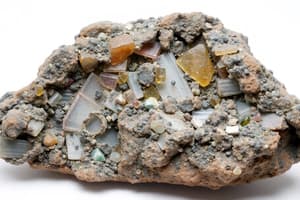Podcast
Questions and Answers
Describe at least three different ways that minerals form.
Describe at least three different ways that minerals form.
Form from magma/lava, form from hot water solutions, form from evaporation.
How can you identify a mineral?
How can you identify a mineral?
By testing the mineral's properties, such as the hardness test, streak test, density test, and observing color, cleavage, and luster.
What is mineral cleavage?
What is mineral cleavage?
Cleavage is the ability of a mineral to break along preferred planes.
What is the hardness of a mineral?
What is the hardness of a mineral?
The hardness scale ranges from _ to _.
The hardness scale ranges from _ to _.
What mineral has a hardness of 10?
What mineral has a hardness of 10?
How do you use the property 'streak' to identify a mineral?
How do you use the property 'streak' to identify a mineral?
What is luster?
What is luster?
What is mineral density?
What is mineral density?
List the five criteria of all minerals.
List the five criteria of all minerals.
List 5 commonly used minerals and their specific uses.
List 5 commonly used minerals and their specific uses.
Name the two types of luster.
Name the two types of luster.
List 5 more commonly used minerals and their uses.
List 5 more commonly used minerals and their uses.
List the following words in order from least to most complex: ______.
List the following words in order from least to most complex: ______.
What is the difference between a rock and a mineral?
What is the difference between a rock and a mineral?
Describe how an igneous rock is formed.
Describe how an igneous rock is formed.
Describe how a sedimentary rock is formed (hint: describe the four steps).
Describe how a sedimentary rock is formed (hint: describe the four steps).
Describe how a metamorphic rock is formed.
Describe how a metamorphic rock is formed.
Flashcards are hidden until you start studying
Study Notes
Formation of Minerals
- Minerals can form from magma or lava cooling and crystallizing.
- Formation can also occur through hot water solutions that precipitate minerals.
- Evaporation of water can lead to mineral formation, leaving behind crystalline deposits.
Identifying Minerals
- Test properties like hardness, streak, density, color, cleavage, and luster to identify minerals.
- The hardness of a mineral indicates its resistance to scratching, measured on a scale ranging from 1 (softest) to 10 (hardest).
- Diamond ranks highest on the hardness scale with a value of 10.
Mineral Properties
- Cleavage refers to a mineral's ability to break along specific planes, which can be a key identifying feature.
- Luster describes how light interacts with a mineral's surface, categorized into metallic and non-metallic types.
- Density pertains to how closely packed a mineral's molecules are and the types of molecules present.
Characteristics of Minerals
- Five essential criteria define all minerals: they must be solid, inorganic, naturally occurring, possess a fixed chemical formula, and exhibit an orderly crystal structure.
Common Minerals and Their Uses
- Halite is used as a food seasoning.
- Mica is a component in paints.
- Quartz serves primary uses in glassmaking.
- Silver is commonly used in jewelry.
- Talc is utilized in the manufacture of baby powder.
- Additional minerals: Graphite is used for pencil lead, Calcite in chalk, Gypsum in plaster and cement, Sulfur in fireworks, and Feldspar in porcelain sinks.
Difference Between Rocks and Minerals
- Minerals are solid, naturally occurring, inorganic substances with a fixed chemical composition and crystalline structure.
- Rocks are aggregates composed of one or more minerals, which may also include organic material.
Rock Formation Processes
- Igneous rocks form when molten rock (magma/lava) cools and crystallizes.
- Sedimentary rocks arise from weathered and eroded rocks that turn into sediments; these sediments are deposited, compacted, and cemented.
- Metamorphic rocks develop under intense heat and pressure, transforming existing rocks into a new form.
Complexity of Matter
- Order of complexity: Atoms, Elements, Minerals, Rocks.
Studying That Suits You
Use AI to generate personalized quizzes and flashcards to suit your learning preferences.




